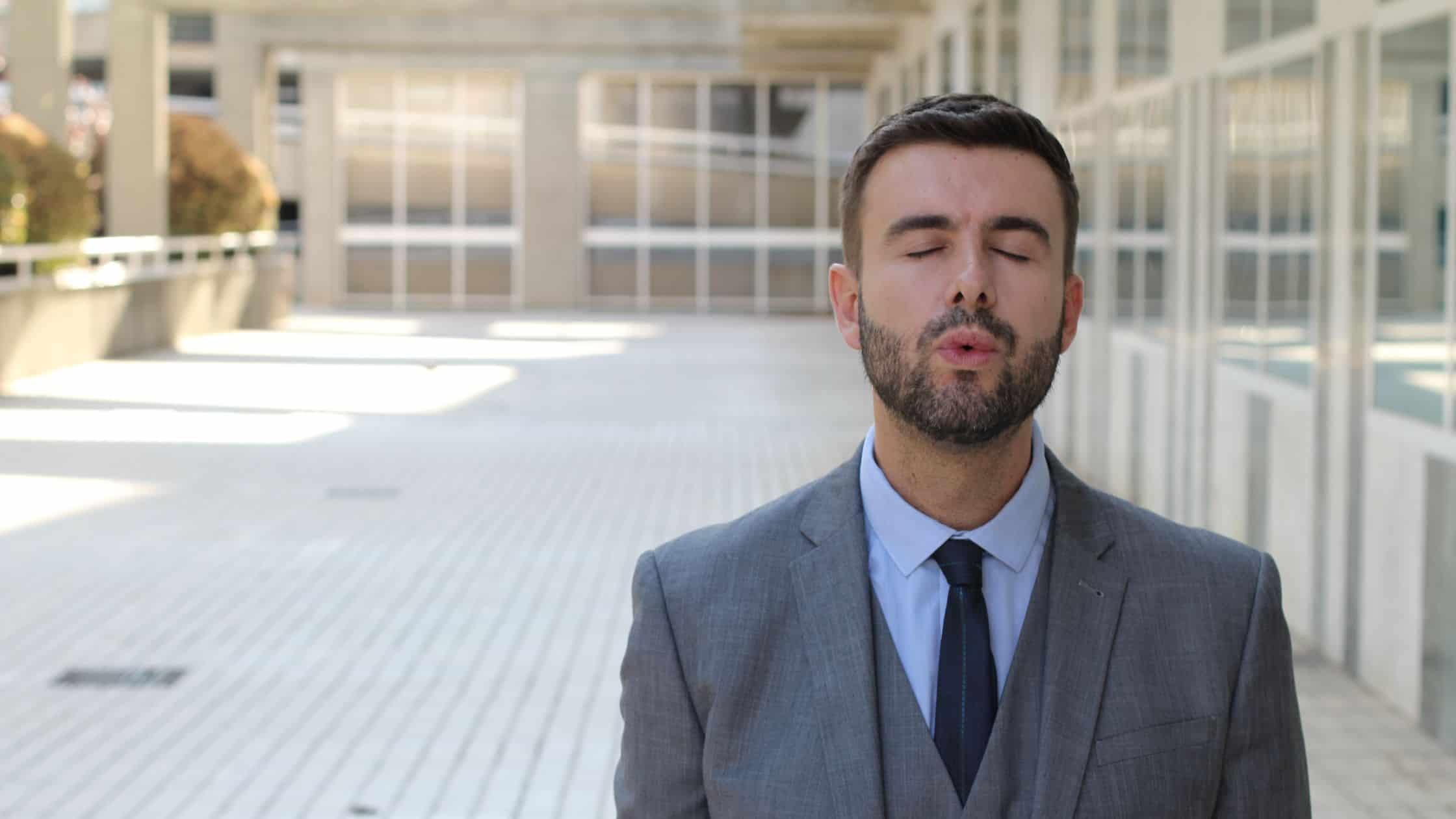No, nope, never. That’s what Zaya told me when I brought up the topic of mindfulness in our career coaching session. I had been working with Zaya to help her succeed in a new leadership role which was a huge leap of responsibility for her.
Zaya told me she had an incessant talk track of why she wasn’t good enough, the people around her weren’t competent, or how work would be better when this person left, that person was promoted, or <fill in the blank>. As we worked together, she realized the louder the stories of judgment were in her mind, the more she lashed out at others, became curt and unfriendly, and started ordering and directing people to do this, that, or the other (which was grossly out of character for her).
She also realized that when these feelings arose, she felt a sense of heat in her neck and chest – she even recognized that she’d make fists and her arms became rigid. And that’s when I suggested mindfulness.
You may be wondering what mindfulness has to do with coaching. Well, the two actually have a lot in common! Just like coaching, mindfulness is all about being present in the moment and focusing on your goals. Mindfulness techniques can help you stay calm and collected when things get stressful, which is essential for success in any career.
We’ll get back to Zaya in a moment, but first, let’s explore how coaching for mindfulness can help you in your career.
What is Mindfulness?

As a leader, you are always looking for ways to improve. You want to be the best that you can be for your team, your company, and yourself. But sometimes, it can be difficult to find new and innovative ways to improve your leadership skills. If you’re looking for a new way to step up your game, mindfulness can unlock some of the performance and productivity skills you’re looking for.
Most people that I speak to about mindfulness or meditation, unless they already have an established practice, seem to either cringe or have a reluctant openness to discuss. But those that engage in a mindfulness approach to leadership seem to excel and progress faster than those that don’t.
For my personal mindfulness practice and the way I use it in coaching, mindfulness is all about recognizing the thoughts and feelings that emerge within you AND (extremely importantly) the body sensations associated with them. For example, I clench my jaw when I’m stressed or anxious. When I notice the all-too-familiar tightness in my jowls, I’ve learned to recognize that as a sign – a sign not to lose my sh*t and blow up. A sign to be ‘mindful’ about what’s causing me to clench and try to uncover the root cause.
And getting back to Zaya, she recognized that the sense of heat in her neck and chest and her rigid fists were a sign or a cue for her. Once we learned to recognize these important cues, Zaya could preempt her self-defeating behavior and instead calm herself, arrive at a neutral place, and proceed from a place of seeking to understand instead of lashing out with judgment.
Even though Zaya was reluctant to discuss the concept of mindfulness, when we explored it further and started engaging in the practice, she realized how omnipresent her judgments were, and she was able to take a step back and find other ways to lead her team.
Mindfulness Is A Tool For Leaders

Mindfulness is not simply a woo-woo thing that should be dismissed because it’s something ‘they’ do. For me, practicing mindfulness has been life-changing, and the missing link to my happiness. Not because I can sit for long periods with a fully quiet mind. Not a chance! A thought seems to enter my head every 3-5 seconds.
Rather, I’ve learned how to be ‘mindful’ of my thoughts and emotions. I’ve learned how to recognize the signals I’m giving myself, and instead of reacting to them with anger, temper, and contempt, I’m now able to absorb the negativity, play with it, dissect it, and over time (sometimes as quickly as the snap of a finger), I’ve learned to keep my reactions in check.
Mindfulness is all about being present in the moment and savoring the experience rather than letting your mind wander off into thoughts about the past or future. This may seem like a difficult task, but there are actually some simple mindfulness techniques you can use to help you stay present and focused.
Mindfulness Techniques To Try
There are many ways to practice mindfulness, whether in a coaching session, at work, or anytime! Here are a few that you can consider:
The Body Scan
The body scan is a mindfulness technique that involves focusing your attention on each part of your body, from head to toe. This helps you to become aware of any tension or tightness you may be holding in your body, and it can also help to relax and release that tension. To do a body scan, simply find a comfortable place to sit or lie down, and then focus your attention on each part of your body in turn. Notice how each part feels, and breathe deeply into any areas that feel tight or tense. For many people, stressful emotions are held in their jaw, shoulders, and back. When doing a body scan, see if you can notice how those areas in particular feel.
Breath Awareness
Breath awareness is another mindfulness technique that can help you to focus and connect. To do this, focus your attention on your breath. Notice the sensation of the air moving in and out of your lungs, and pay attention to the rise and fall of your chest as you breathe. You can also notice the temperature of air entering and leaving your nostrils. Breathe slowly and deeply, and try to let go of any thoughts or worries that might be running through your mind. Just focus on the sensation of breathing.
I really like this technique for a quick “check-in” for myself or my clients when we notice something coming up in our body. It’s an easy way to slow down and reset when things seem to be moving in the wrong direction. A simple exercise to do with breathing is to count the same number on the inhale and exhale. For me, it’s usually 5 – I count to five as I breathe in, and then count 5 as I breathe out.
Visualization
Visualization is a powerful mindfulness technique that can help you to achieve your goals. To do this, simply close your eyes and imagine yourself achieving the goal you have set for yourself. Visualize every detail, from the way you will feel to the way you will look when you reach your goal. See yourself succeeding and believe that it is possible. The more vividly you can imagine it, the better! Visualization is a great tool to help overcome impostor syndrome or to calm those jitters when you are going for a job interview.
Visual mindfulness can also help when your mind wanders during Zoom meetings. Nowadays, when I notice this happen, I pay close attention to the frame of the person I’m talking to. The pictures on the wall. Plants in the background. Paint color. I even notice people’s hair, the color, their eyes, and the way their mouth moves as they speak. All these visuals help me stay focused instead of letting my mind wander.
What About When I Get Triggered?

One of the biggest questions I get on the topic of mindfulness is how to remain mindful when we’re triggered. For example, that annoying colleague or coworker has done that irritating thing AGAIN, and you’re about to blow. How do you keep the trigger in check?
As easy as this sounds, and as difficult it is to put into practice, you’ve got to get out of your head. Yes, I know, that sounds counterintuitive when we’re talking about being mindful. But when we succumb to the judgey stories in our head, they compound. We justify and validate the judgment. And the more we do that, the more we fuel the fire until we blow, lose our temper, retreat, or act out of character.
When we are triggered it’s important to recognize what’s going in inside our minds and also in our bodies, and then do some sort of practice, activity, or mindfulness exercise to get out of our mind and focus on something around us, like some of the techniques listed above. For example, you could do a quick body scan or breath awareness exercise.
Another technique that is great when you are triggered is as simple as concentrating on the sound of the person’s voice, the sparkle in their eye, or the sound of the heater or AC kicking on. It doesn’t have to be a whole meditation session! Instead, take that pause and then try to proceed with neutrality as best you can – meaning, don’t assume you know, don’t assume they are as dumb or incompetent as you think they are, or whatever other judgement is coming up. Being neutral means proceeding when you are calm and collected.
How Can I Get The Best Out Of Mindfulness Practice?

Here are my 3 top coaching tips for using mindfulness as a leader:
1 – Being mindful is all about being open. If you’re not willing to try it, then quite frankly, you’re not open enough to the positive benefits of mindfulness. So if you think you’re ready to improve, evolve, or transform your leadership, be open to trying it.
2 – Have a plan. There are a lot of mindfulness teachers, gurus, and experts out there, each with their own flavor of the same dish (ie, they have their own take on mindfulness). Find a teacher you like well enough and try their style. I have my teacher and my own style that I use in my coaching practice, but you may connect with a different style, and that’s ok!
3 – Be patient and give it the old college try. In my opinion, that’s 30 days at a minimum. If you try a mindfulness practice, don’t expect it to move mountains or have an immediate impact out of the gate. It takes time. Be patient, try it. See what happens.
Summing It Up
Mindfulness is a valuable tool for leaders because it helps them focus on the present moment and connect with themselves and their team, as well as providing an outlet when they get triggered. If you are looking to improve your leadership skills, I highly encourage you to implement some mindfulness techniques. Body scans, breath awareness, and visualization are all great options that can help you to become a better leader – and they don’t have to be all woo-woo and include an hour of meditation every morning!
If you’re not sure how to get started with mindfulness, try some of the simple techniques I’ve outlined above. You don’t even have to call it mindfulness, if that doesn’t resonate with you. Just think of it as another tool in your leadership toolbelt. Just like Zaya, soon enough, you’ll be reaping the benefits of this powerful practice!
Did you like this article? You might also like:
Conscious Leadership: How To Be A Leader Others Want To Follow
6 Uncommon Interviewing Skills That Will Get You Hired
3 Crucial Considerations When Choosing A Career Coach: A Coach’s Perspective




